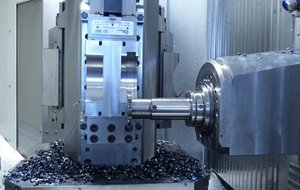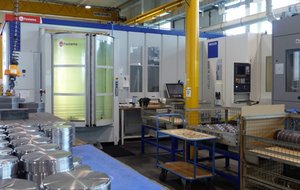The decision to invest in the two HELLER 4-axis machining centres H 2000 and H 5000 was made very quickly after an intensive benchmark. The decisive factors were the proximity of the service centre, the cooperative advice during the decision-making process and the stability and performance of the machining centres. After one year, STADLER sees its decision more than confirmed. With both the H 2000 and the H 5000, we are currently able to produce 60 percent more components.
Old machine tools do not necessarily belong to the scrap heap. But when a machining centre has been used for 20 years, it is time to reorient itself for economic reasons alone. That's why STADLER decided in 2019 to invest in two new machining centres and bring the partially outsourced production back in-house. After an intensive benchmark, the decision was made in favour of the H 2000 and H 5000 horizontal 4-axis machining centres from HELLER. One year after commissioning, STADLER sees its decision more than confirmed, because on the one hand the machining centres meet all requirements such as stability, performance and reliability. With the H 5000 including a 10-fold pallet storage from Fastems, components with predominantly large bores and corresponding power (PowerCutting HSK-A 100 gear unit with 8,000 rpm, 43 kW and 822 Nm) are machined. The H 2000, on the other hand, is used with a standard pallet changer and a directly driven HSK-A 63 spindle (10,000 1/min, 38 kW, 242 Nm). On the other hand, according to Roland Fiesel, Team leader of mechanical production at STADLER, the machining centres reduce cycle times in a way that was not originally planned: "We deliberately decided to use horizontal machining because of the possibility of multiple clamping and the optimum chip fall. However, a piece time calculation was not part of our requirement. It is therefore all the more pleasing that we were able to halve the piece times for a component with numerous bores, for example, which are spindled out. The tool handling plays a major role in this. With the H 5000, this is a chip-to-chip time of only four seconds. We are talking about insert drills between 50 and 55 mm in diameter. And of course, automation also contributes to this, because we now go to the machine with eight workpieces in multiple clamping. However, the reduction in piece time also results from the main times, because we are significantly faster with new strategies and cutting values." For this quantum leap in piece time reduction, investments were made in new fixtures and new tools in Altshausen.
Sufficient resources strengthen mechanical production
All in all, the two HELLER machining centres are currently capable of producing 60 percent more components. Even if this cannot be compared with the previous machines. The fact is that STADLER has been able to create enormous resources and bring the added value of outsourcing back in-house. Facts that are of enormous importance to Bruno Stützle, Head of Production and authorised signatory at STADLER: "STADLER Anlagenbau is growing continuously and building more and more plants. In addition, we now manufacture the components that were previously outsourced. Now, as a plant manufacturer, we see our core competence in engineering. This in-house value creation and the associated delivery reliability strengthens our mechanical production. Here we manufacture series products for our standard machines, and the spare parts business is also constantly increasing. That's why we firmly expect to produce even more here at the site in the future. So of course these additional resources are reassuring."
Up to now, STADLER has only worked in a single shift. The machines run unmanned for a maximum of up to six hours in the second shift. However, the Fastems pallet storage system was not even on the agenda during the initial discussions. On the contrary, they were of the opinion that the plant would be oversized. Today, however, they see things differently, because the 10 pallets are completely filled with fixtures. With the two machining centres, on the other hand, no options were taken. The specified tolerances of a few hundredths of a millimetre are easily achieved without a precision package.
The H 2000 and H 5000 machining centres have now been under chip removal for a year, and without any problems. Therefore, Roland Fiesel and Bruno Stützle agree that HELLER was the right choice: "It was our first contact with the company HELLER or Mr. Peter Greising from the area agency Hans P. Greising GmbH. We visited the production facilities in Nürtingen and at every step we took we had the feeling that HELLER took us seriously and listened to our wishes. We decided on the two machining centres because of the price-performance ratio and the service, but also because of this cooperative partnership.
Interesting facts
A STADLER plant that sorts out 100,000 tonnes of high-purity plastic per year contributes to the avoidance of 150,000 to 320,000 tonnes of greenhouse gas per year. This corresponds to the average annual greenhouse gas emissions of about 16,000 to 36,000 people in Germany.




